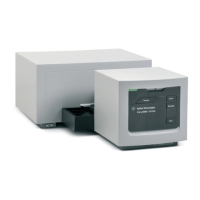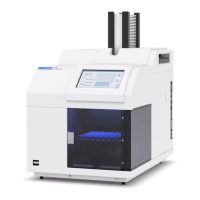20
Theory of Operation
Optical System Overview
Source Lens
The source lens receives the light from both lamps and collimates it. The
collimated beam passes through the sample (if one is present) in the sample
compartment.
Shutter
The shutter is electromechanically actuated. It opens and allows light to pass
through the sample for measurements. Between sample measurements it
closes to limit exposure of sample to light. If the measurement rate is very
fast, you can command the shutter to remain open (ChemStation software)
or it stays open automatically (handheld controller software).
Stray-Light Correction Filter
In a standard measurement sequence, reference or sample intensity spectra
are measured without and then with the stray-light filter in the light beam.
Without the filter the intensity spectrum over the whole wavelength range
from 190–1100 nm is measured. The stray-light filter is a blocking filter with
50 % blocking at 420 nm. With this filter in place any light measured below
400 nm is stray light. This stray-light intensity is then subtracted from the first
spectrum to give a stray-light corrected spectrum. Depending on the
software, you can switch off the stray light correction (ChemStation
software) in case you want to do very fast repetitive scans or it is switched
off automatically (handheld controller software).
Sample Compartment
The spectrophotometer has an open sample compartment for easier access
to sample cells. Because of the optical design a cover for the sample area is
not required. The spectrophotometer is supplied with a single-cell cell holder
already installed in the sample compartment. This can be replaced with the
Peltier temperature control accessory, the thermostattable cell holder, the
adjustable cell holder, the long path cell holder or the multicell transport. All
of these optional cell holders mount in the sample compartment using the
same quick, simple mounting system. An optical filter wheel is also available
for use with the spectrophotometer and most of the accessories.
Spectrograph
The spectrograph housing material is ceramic to reduce thermal effects to a
minimum. It main components of the spectrograph are the lens, the slit, the
grating and the photodiode array with front-end electronics. The mean

